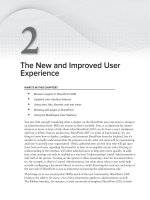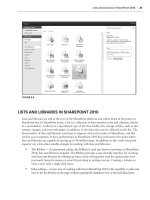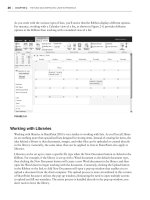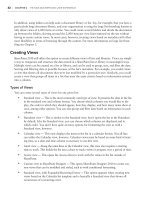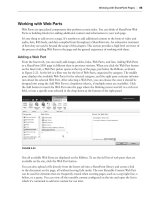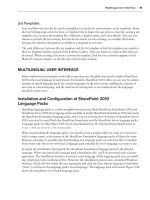Thủ thuật Sharepoint 2010 part 84 pptx
Bạn đang xem bản rút gọn của tài liệu. Xem và tải ngay bản đầy đủ của tài liệu tại đây (776.81 KB, 8 trang )
622
CHAPTER 21 NeW coNteNt maNagemeNt caPaBilities iN sharePoiNt 2010
Document sets can be versioned. This mechanism is independent of individual document ver-
sioning, and it does not replace versioning of individual documents in the set. Both versioning
features can both be used simultaneously.
Workflows can be associated with the group.
Permissions can be defined for the group.
New pages are provisioned for the document set. The welcome page is essentially a landing
page that displays the contents of the set and its properties. This Web Part page can be used
directly or it can be customized as needed.
Clearly, this type of capability has immediate use for things like sales proposals or Request for Proposal
(RFP) documents, which are composites of multiple documents. Both of these examples typically
require the creation of multiple documents, and document sets automate this process. The customiz-
able landing page, or welcome page, provides users with guidance on how to use the document set
and what is contained in the set. The capability to update metadata for all content within the set at
one time is a huge advantage.
Configuring and Creating Document Sets
Before attempting to configure a document set, ensure that the Document Sets feature has been acti-
vated. Navigate to the Site Settings page for your site collection as shown in Figure 21-1 and click
the link for Site Collection features beneath the Site Collection Administration heading.
FIGURE 211
Document Sets
623
Scroll down the list of features until you see the Document Sets feature and activate the feature if it
is not already activated, as shown in Figure 21-2. Once the feature has been activated, use the fol-
lowing steps to configure the specific document library to allow document sets:
1. Navigate to the specific library of interest and select the Library tab that is part of Library
Tools on the Ribbon. Click the Library Settings button on the far right of the ribbon to
reveal the Document Library Settings page, as shown in Figure 21-3.
FIGURE 212
FIGURE 213
624
CHAPTER 21 NeW coNteNt maNagemeNt caPaBilities iN sharePoiNt 2010
2. Under the General Setting category on the Document Library Settings page, click the Advanced
settings link. Ensure that “Allow management of content types?” is set to Yes, as shown in
Figure 21-4, and click OK.
FIGURE 214
3. You now need to add the Document Set content type to the library. From the Document Library
Settings page, you will notice a new section called Content Types, as shown in Figure 21-5.
Notice that the Document content type is the only content type defi ned in this library. This is
the default content type. Click the “Add from existing site content types” link. This should
take you to the Add Content Types page.
FIGURE 215
4. From the Add Content Types page, select the All Groups option in the “Select site content
types from:” drop-down box. Choose Document Set from the list of Available Site Content
Types: and click the Add > button as shown in Figure 21-6. Then click OK.
5. This completes the confi guration and now it’s time to create a new document set. Click
the New Document button from inside the confi gured library and you should see that the
Document Set content type has been added to the list (see Figure 21-7).
You can change the order of the two different content types from the Library
Settings page if necessary. This could be important if a large number of content
types have been confi gured.
Document Sets
625
FIGURE 216
FIGURE 217
6. Click the Document Set option from the New Document menu. Enter a name and a descrip-
tion for the document set and then click the OK button as shown in Figure 21-8.
626
CHAPTER 21 NeW coNteNt maNagemeNt caPaBilities iN sharePoiNt 2010
FIGURE 218
This will produce the document set’s welcome page, shown in Figure 21-9. Notice that a new
group called Document Set has been added to the Ribbon, and this includes the Manage tab.
Administrators should familiarize themselves with the options available on the Manage tab.
FIGURE 219
7. To upload multiple documents, select Upload Document from the Ribbon, and then select
Upload Multiple Documents. The new Upload Document dialog is displayed, as shown in
Figure 21-10. Documents and folders can be dragged directly onto the window or you can
browse for the documents. Upload several documents to the document set. An example is
Document Sets
627
shown in Figure 21-11. Notice that several options are available from the Manage tab. If the
Capture Version and Version History buttons are disabled, you need to enable versioning for
this document library.
FIGURE 2110
FIGURE 2111
Returning to the default library view, note that the document set is classified as a single
object. Take some time to review the options available from the drop-down menu for the
document set.
628
CHAPTER 21 NeW coNteNt maNagemeNt caPaBilities iN sharePoiNt 2010
Customizing the Document Set
Document sets can be customized. There is a settings page that provides additional configuration
options so let’s take a brief look. In general, a specific document set that is associated with a docu-
ment library can be customized using the process described here. In addition, an enterprise document
set could also be created. If so, it is best to create a custom Document Set content type that inherits
from the base Document Set content type, and then perform the customization on the inherited
content type. This keeps the out-of-the-box Document Set content type unmodified.
You can view the settings for a Document Set content type that has been associated with a library
by clicking the Document Set link on the library settings page in the Content Types section, and
then clicking the Document Set Settings link on the Document Set page. This will reveal the settings
page shown in Figure 21-12. The figure shows only some of the available options; scroll down to
review all of them. Table 21-3 describes the Document Set content type options.
FIGURE 2112
Because the Document Set is a content type, you can in fact add additional content types to your
document set. You can also predefine content that you would like included in the document set and
it will be automatically added when new sets are created. Metadata columns can be shared across
items in the set. If you add a new column to the document set itself, that column becomes available
for sharing with the documents contained in the document set. The columns that are displayed on
the document set home page can also be defined. Lastly, you can even edit the home page’s layout,
design, and contents.
Document ID Service and IDs
629
TABLE 213 Document Set Content Type Settings
OPTION DESCRIPTION
Allowed Content Types Other existing content types can be added and removed from the
Document Set content type.
Default Content This allows the newly created document set to include specific items,
content, documents, etc. Content can be selected by browsing directly
to the files.
Shared Columns A shared column is a column that is available for all documents in the
set. Each of the columns in the content type can be shared, which
means the column values will be automatically synchronized to all
documents in the set.
Welcome Page Columns This option defines which columns are displayed on the welcome
page for the document set.
Welcome Page View The specific view that is used to display the document set’s contents
can be chosen with this option.
Welcome Page This option enables the welcome page to be customized either
directly in the browser or using SharePoint Designer 2010.
DOCUMENT ID SERVICE AND IDS
The Document ID service is a new capability at the site collection level that adds a unique identifier
to all documents throughout the site collection. This ID is used to locate and retrieve documents
regardless of their current or future location.
In SharePoint 2007, links break if you rename or move a file. Therefore, one of the desired features
that users of SharePoint 2007 asked for is persistent links. This is the capability to link directly
to a unique object ID. Using this system, each document or individual piece of content, or content
object, would have its own unique ID that doesn’t change regardless of where it is stored or moved
in the repository. Persistent linking enables the management of compound documents, as discussed
earlier in the section on document sets, and the capability to link directly to an older version of a
document. In SharePoint 2010, document IDs provides absolute reference to objects regardless of file
renames or content moves.
Document ID capability is activated and managed at the site collection level. This capability includes
an ID value and the ID service. IDs can be used to retrieve items independent of their current location.
The ID service supports this process by generating and assigning the IDs. Once the ID is assigned, a
static URL can be used to locate the document based on its ID. Static URLs work correctly at the site
collection level because the web browser manages the redirect before it invokes the specific Office cli-
ent application. The ID service generates IDs for all documents in the site collection, but it does not
generate IDs for other types of list items. IDs are generated every time a new document is created. The
ID is retained during move operations and a new ID is created when a document is copied.


